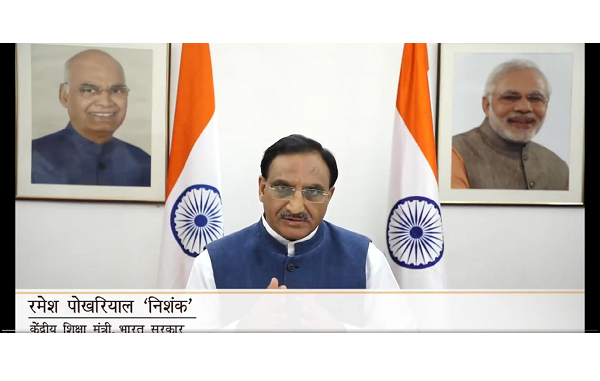
Oct 05: Department of School Education and Literacy, Ministry of Education has issued SOP/Guidelines for reopening of schools today. Union Education Minister Shri Ramesh Pokhriyal ‘Nishank’ announced regarding SOP/Guidelines of DoSEL for reopening of schools through his tweet.
BRIEF HIGHLIGHTS OF THE SOP/GUIDELINES OF DEPARTMENT OF SCHOOL EDUCATION & LITERACY FOR REOPENING OF SCHOOLS
- As per para -1 of MHA order no. 40-3/2020-DM-I(A) dated 30.09.2020 for reopening, States/UT Governments may take a decision in respect of the reopening of schools and coaching institutions after 15.10.2020 in a graded manner in consultation with the respective schools/institutions management and based on the local situation.
- Part I refers to the health and safety aspects of reopening schools. These are based on the prevailing instructions of the Ministry of Home Affairs and Ministry of Health and Family Welfare with regard to health and safety protocols and may be implemented by adopting/adapting in accordance with the local situation in all states/UTs.
- Arrange and implement for thorough cleaning and disinfecting of all areas, furniture, equipment, stationery, storage places, water tanks, kitchens, canteen, washrooms, laboratories, libraries, etc. on school campus and ensure airflow in indoor space.
- Schools to form Task Teams such as Emergency Care Support/Response Team, General Support Team for all stakeholders, Commodity Support Team, Hygiene Inspection Team, etc. with earmarked responsibilities will be helpful.
- Schools may be encouraged to make their own SOPs based on the guidelines issued by States/UTs for the following, keeping in view the safety and physical/social distancing norms, and ensuring that the notices/posters/messages/communication to parents in this regard are prominently displayed/disseminated.
- Physical distancing / social distancing to be ensured while planning the seating plan, functions and events to be avoided, staggering of entry and exits timings and points of schools, staggered time tables.
- All students and staff arrive at school wearing a face cover/mask and continue wearing it all through, especially when in class, or doing any activity in groups, such as eating in the mess, working in the laboratories, or reading in the libraries.
- Display Signages and markings for enforcing physical/social distancing and safety protocols at adequate places. States/UTs should take the consent t of parents/guardians before their child/ward begins attending schools. Students willing to study from home with the consent of the parents may be allowed to do so.
- Sensitize students, parents, teachers, community members, and hostel staff on COVID-19 related challenges and their role to be conducted based upon guidelines issued by the Ministry of Education, Ministry of Home Affairs, and the Ministry of Health and Family Welfare with all the stakeholders.
- Plan for academic calendar changes for all classes, particularly in relation to breaks and exams. Ensure all students have access to prescribed textbooks before school reopens.
- Ensure availability in school or at contactable distance full-time trained health care attendant/nurse/doctor and counsellor to take care of the physical and mental health of the students. Regular health check-ups of students and teachers may be organized.
- Adequate information should be collected from students, parents, and teachers upon the health status. From local administration: About the State and district helplines and the nearest COVID Centre and other contact details for dealing with emergency.
- Flexible attendance and sick leave policies may be developed and implemented to encourage students and staff to stay at home when sick.
- Actions to be as per the Protocol defined in case of detection of a suspected case of COVID-19.
- Focus on the most vulnerable students (homeless/migrated students, students with disabilities, and students directly affected by Covid-19 through a family death or hospitalization) to prioritize their needs. Ensure the provision of assistive devices and learning content as per the needs of the CwSN.
- To meet the nutritional requirements of children and safeguard their immunity during the COVID-19 outbreak, States / UTs were advised to provide hot cooked Mid-Day Meal or its equivalent Food Security Allowance to eligible children during closure of schools and summer vacations. Adequate focus on food safety, health, and hygiene along with physical/social distancing.
- Part II refers to learning with physical/social distancing and the academic aspects related to the delivery of education, such as curriculum transactions, instructional load, timetables, assessment, etc. These are advisory in nature. States &UTs may use these in the manner deemed fit to prepare their own guidelines.
- Making a Comprehensive Alternative Calendar of Activities for the Whole Year with a focus on learning outcomes. The academic calendar may be realigned for the whole year in accordance with the emerging situation. A comprehensive academic plan can be prepared as per the guidelines received from the concerned Directorate of Education. This plan may follow the guidelines of the Alternative Academic Calendar prepared by the NCERT.
- The reintegration of students into school may be taken on priority after reopening.
- Teachers must polish their skills for integrating ICT in class as far as possible. Training modules may be prepared for the same.
- Children can also be sensitized about the pandemic by integrating various concepts into the teaching of various subject areas such as EVS, languages, science and social science, arts.
- Teachers must discuss with the students the clear roadmap of the curriculum, the modes of learning to be adopted (through face to face instruction/individual assignments or portfolios/group-based project work/group presentations, etc.) to be covered, the time to be taken for the same, dates of school-based assessments, breaks, etc.
- Focus on the most vulnerable students (homeless/migrated students, students with disabilities, and students directly affected by Covid-19 through a family death or hospitalization) to prioritize their needs.
- Divergent use of teaching resources shall have to be relied upon keeping physical/social distancing and other safety norms in mind. Resources could include peer teaching and learning, use of workbooks and worksheets, use of technology-based resources in class, empowering parents/grandparents/older siblings to teach, using the services of volunteers from the community, etc.
- PRAGYATA Guidelines on digital and online education can be used to orient teachers and students in this regard. If the State/UT has Energized Textbooks, inform students and parents how to download the e-content behind the QR on DIKSHA, codes, and use the same in offline mode, thereon.
- Teachers, parents, and administrators need to focus on formative assessment to ensure the achievement of learning goals by all learners. Guidelines of SCERT/NCERT may be used to sensitize parents to improve their understanding of and appreciation for formative assessment.
- Schools to ensure a smooth transition of students from home-based schooling during lockdown to formal schooling. Schools can implement a re-adjusted school calendar and redesigned Annual Curriculum Plan (ACP), remedial classes, or conduct back to school campaign among other steps.
- The teachers, school counselor,s and school health workers should work in unison to ensure the emotional safety of their students. ‘MANODARPAN’ covers a wide range of activities to provide psychosocial support to students, teachers, and families for Mental Health and Emotional Wellbeing during the COVID outbreak and beyond.
- Based on these SOP/guidelines, State / UT Governments need to develop their own Standard Operating Procedures for reopening schools and for training different stakeholders as and when the State/Union Territory Governments declare it safe for schools to operate.
- Checklists for a safe school environment which includes for different stakeholders, for building resilience and for academic planning and school operations may be used.
- The State/UT Education Departments may conduct awareness and capacity building programs for DIET faculty members, School Heads, Teachers, and Parents before the opening of the schools.



